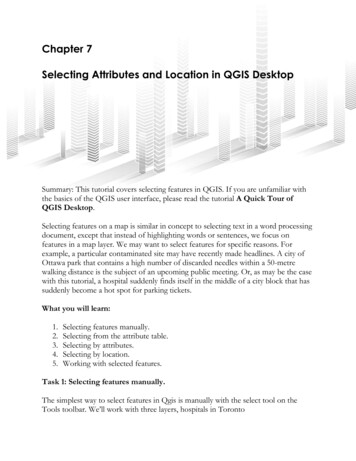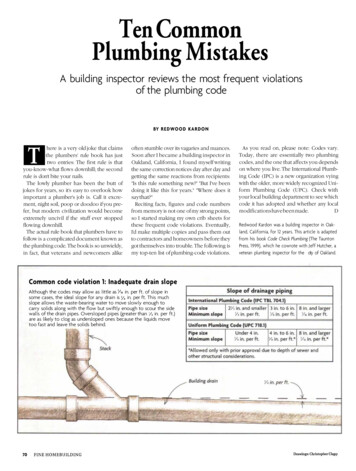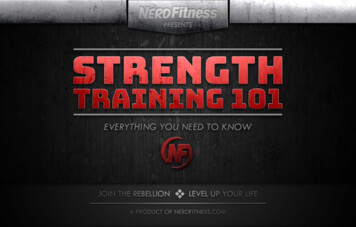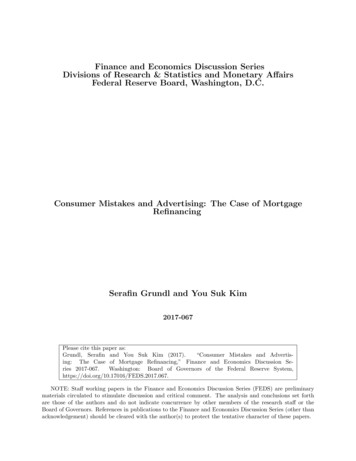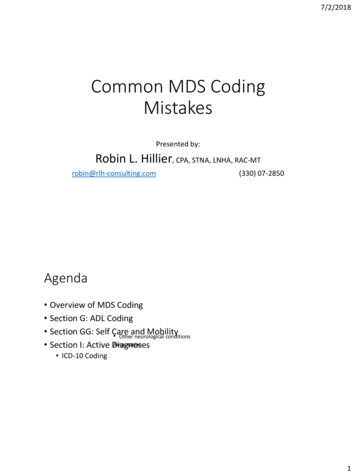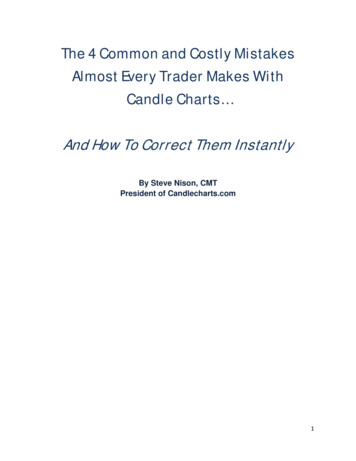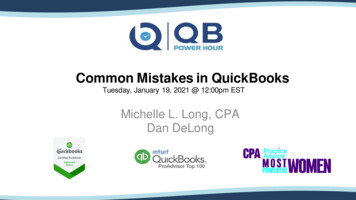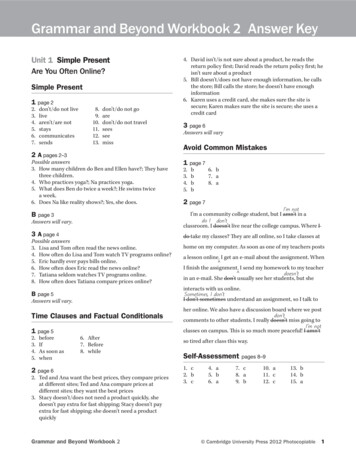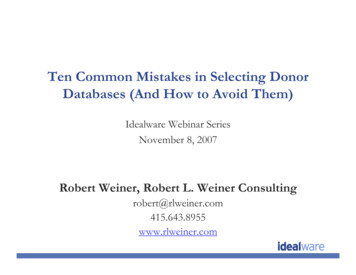
Transcription
Ten Common Mistakes in Selecting DonorDatabases (And How to Avoid Them)Idealware Webinar SeriesNovember 8, 2007Robert Weiner, Robert L. Weiner ner.com
What We’ll Cover Who should make the decision?What will a new database cost?Assessing your needs.Comparing databases.Conducting due diligence.Implementation and ongoing support.Resources.Questions.Robert L. Weiner: Ten Common Mistakes1
Mistake #1:Letting Techies Make the Decision Include techies on the selection team, but don’t letthem make the decision alone. Functional experts (fundraisers, program officers,finance) should drive the decision-making. Include the real users in the process (data entry,report creation, managers). The decision should be based on input from allaffected parties. Clarify team’s role at the start: advisory, majorityrule, or consensus.Robert L. Weiner: Ten Common Mistakes2
Mistake #2: Wishful Budgeting Software is often a fraction of the total cost. Prices range from 500 to – Also Open Source & Freeware, but may lacksupport, training, documentation, good interfacedesign. Plan for additional modules, support, training,conversion, consulting assistance. If you can’t afford the maintenance ortraining, don’t buy the software!Robert L. Weiner: Ten Common Mistakes3
2.2 What Should You Budget For? Software (of course)Hardware (server(s) and desktops)?Network upgrades?Implementation assistance?Training – will you need more than thestandard? Customizations? Interfaces to other systems?Robert L. Weiner: Ten Common Mistakes4
2.3 What Will It Cost? Ballpark starting price: 0.25% to 0.5% ofannual operating budget. 1M budget 2,500to 5,000. Annual support: 20% of retail price. Conversion cost will depend on:– How much and what kinds of help you will need: data migration, custom programming, help with businessrules, report creation, training.– What shape (and how many places) your data is in.Robert L. Weiner: Ten Common Mistakes5
2.4 Sample 5 Year BudgetItemSoftwareStaff trainingWorkstationsShared PrinterConsultingSupport, years 2 - 5Ongoing TrainingWorkstation UpgradesRobert L. Weiner: Ten Common MistakesUnit155120CostTotal 5,000.00 5,000.00 750.00 3,750.00 1,250.00 6,250.00 350.00 350.00 125.00 2,500.00Total Year 1 17,850.00425 1,000.00 4,000.00 750.00 1,500.00 1,250.00 6,250.00Grand Total 29,600.006
Mistake #3:Prioritizing Price above Everything Know your needs. Don’t fall in love with a vendorthat doesn’t fit your requirements. Buy the product that meets your top needs, fits yourresources, and offers the best price. Accept a donation (whether software or services) onlyif it fits your selection criteria.Robert L. Weiner: Ten Common Mistakes7
3.2 Assessing Your Needs What’s wrong now? How do you raise money (grants, pledges, directmail, memberships, telemarketing, major gifts,events, sponsorships, email)? What do you need to track and analyze? What reports do you need? Where do you see the organization in 5 years? Identify mandatory needs, prioritize the rest.Robert L. Weiner: Ten Common Mistakes8
3.3 Prioritizing Your NeedsSource: www.npowerseattle.org/education/resources/donor toolkit.htmRobert L. Weiner: Ten Common Mistakes9
Mistake #4: Randomly Looking at Demos Start with requirements. Identify possible vendors. Optional: Request for Proposals (RFP). Invite a few vendors to present scripteddemos reflecting real-life needs.Robert L. Weiner: Ten Common Mistakes10
4.2 Randomly Looking at Demos Vendors must fit your culture, staffing, andbudget, as well as meeting functional needs. Vendors should have demonstratedexperience addressing your issues. Consider what worked at your last job only ifthe needs and organizations are similar.Robert L. Weiner: Ten Common Mistakes11
4.3 Identifying the Vendor Pool Ask similar organizations, as well as on lists likeTechSoup, CharityChannel, InformationSystems Forum. Feel free to accept input from board members,donors, volunteers, or the boss, but make aneducated, collaborative decision. Optional: Issue a Request for Proposals (RFP)Robert L. Weiner: Ten Common Mistakes12
4.4 Optional: Issue a Request For Proposals Goal is to narrow the vendor field. Ask clear, unambiguous questions. Be Specific:– “Show how your system would handle donations in , , , and ” not “Can it track gifts?”– “Show where your system would track cateringcosts” not “Can it handle events?” Anything you ask for you will have to read andscore!Robert L. Weiner: Ten Common Mistakes13
4.5 Software Demonstrations Goal: comparing “apples to apples.” Use on-site demos when possible. Either tell vendors which areas you need to seeor use a script. Demos must cover the most critical functionsidentified by your needs assessment. Try to get your hands on the software. Ask fora demo copy or access to an online account.Robert L. Weiner: Ten Common Mistakes14
4.6 Software Demonstrations Sample of a Demo Script:– Add a record for Barney Rubble, with a 25 gift.– Add a separate record for Elizabeth McBricker, with a 10,000 multi-year pledge.– Marry the two records, change Elizabeth’s name to BettyRubble, and show joint giving.– They divorce. Show the database process. Are both of themstill major donors?– Create a mailing list of donors over 500 cumulatively since2004, who have attended at least 1 event since 2004, and livein the 9 Bay Area counties.Robert L. Weiner: Ten Common Mistakes15
4.7 Grading The Vendors Make sure key stakeholders can attend. Invite all interested staff. Collect input from everyone.Simple rating form:AREARATING COMMENTSData EntryMembership Mgmt.Prospect ManagementEvents ManagementRobert L. Weiner: Ten Common Mistakes16
4.8 Grading The VendorsVendor1Vendor2Vendor3Complex rating form, with scores for each feature:Tracking membership renewal anniversariesTracking major gifts prospect movesTracking event costsTracking volunteer hoursRelationships can be tracked between records(employer/employee, spouses, board members)System allows for soft crediting of giftsSystem tracks scheduling of pledge paymentsHas a built-in custom report writer109561088301096651010791010910105Has canned reports that meet the majority of our needsGrand Total7737651071Feature/RequirementRobert L. Weiner: Ten Common Mistakes17
Mistake #5:Falling in Love with Cool Features Focus on features that meet your needs,customer support, Total Cost of Ownership,vendor viability and reputation, risk, etc. The VENDOR is the single most importantdecision factor; if they disappear, you’ll have todo this all over again.– The right vendor will keep up with changingtechnologies.– The right vendor will provide good training &support.– The right vendor will provide usable documentation.Robert L. Weiner: Ten Common Mistakes18
5.2 Remember to Focus on Core NeedsYour Database Should Tell You Things Like: Who gave?– How much, when, and and for what purpose?– How much have they given this year? Ever? Largestsingle gift? For how many years?– Who are your biggest donors? Who’s interested in what (programs, advocacy)? What was your last contact? What’s next? Whom should we invite to this event? Ask for alarger gift this year?Robert L. Weiner: Ten Common Mistakes19
Mistake #6:Falling in Love with the Salesperson You’re not buying the salesperson. You might never see the salesperson again! Check references. Sample reference checkquestions: www.rlweiner.com/case handbook chapter.pdfRobert L. Weiner: Ten Common Mistakes20
Mistake #7: Buying More Than You Need Don’t buy a Ferrari if you only need (or canafford or maintain) a Civic. With some systems, you can start small andadd modules and users as needed. Plan for the future, but make sure you can useit now. Caveat: underbuying can be an equally seriousmistake.Robert L. Weiner: Ten Common Mistakes21
Mistake #8: Confusing Highly FunctionalSoftware with Highly Trained Staff Un/under-trained staff, lack of communication, andpoor management will not be solved by new software.In fact, the problems may get worse. Higher-end software requires more computer skillamong users, not less. Complex software must be properly configured. Thismay require help from the vendor or a consultant. Look at people and procedures before you look atsoftware. What can be fixed without a new system?Robert L. Weiner: Ten Common Mistakes22
Mistake #9:Hoping the Database Will Install Itself Who will manage the project? Who else needs to beinvolved? How will it impact the daily workload and otherpriorities? Will you need more staff? How much cleanup will your data require? How will you integrate with other systems? Run “parallel” as a LAST resort; invest the time andmoney in testing.Robert L. Weiner: Ten Common Mistakes23
Mistake #10:Leaving the Database to Fend for Itself Who will be responsible for quality control? Who will provide ongoing training? How will daily operations change? How will job duties change? Will you need more staff? Will existing staffneed new skills?Robert L. Weiner: Ten Common Mistakes24
Mistake #11: Building Your Own DatabaseWhy Not Build Your Own? Risk (how do you know it will work?). Distraction (fundraisers must become databasedesigners). Support & Maintenance (who you gonna call?). Documentation (will there be any?). Training (a game of “telephone”?). User Community (there won’t be one). Cost (how can you get a firm price?).Robert L. Weiner: Ten Common Mistakes25
Recap Involve stakeholders in the decision. Decide what you’re looking for. Structure demos so you can compare “apples toapples.” Make sure you understand all the costs. Trust but verify (check references and test thesoftware). Plan for implementation and ongoing support. If you can’t afford training and maintenance,don’t buy the software.Robert L. Weiner: Ten Common Mistakes26
ResourcesBatchelder, Duff: Evaluating & Selecting Fundraising age4829.cfmBattin, Tom: Should Nonprofit Agencies Build or Buy a /page5028.cfmIdealware: articles on constituent databaseswww.idealware.org/articles/constituent databases.phpTechSoup: Selecting Donor Management page4797.cfmTechSoup’s Technology for Fundraising discussion forumwww.techsoup.org/forums/index.cfm?fuseaction list&forum 2022&cid 117Weiner, Robert: Ten Common Mistakes in Selecting Donor Databaseswww.idealware.org/articles/ten common mistakes in selecting donor databases.phpWeiner, Robert: Why Building Your Own Database Should Be Your Last Resortwww.rlweiner.com/nten/why building your own database should be your last resort.pdfWeiner, Robert: Looking for Databases in All the Right Placeswww.rlweiner.com/articles/weiner npq article.pdfMore resources are posted at www.rlweiner.com/resources.htmlRobert L. Weiner: Ten Common Mistakes27
Idealware Webinar Series November 8, 2007 Robert Weiner, Robert L. Weiner Consulting robert@rlweiner.com 415.643.8955 www.rlweiner.com. 1 Robert L. Weiner: Ten Common Mistakes . How do you raise money (grants, pledges, direct mail, memberships, telemarketing, major gifts,

